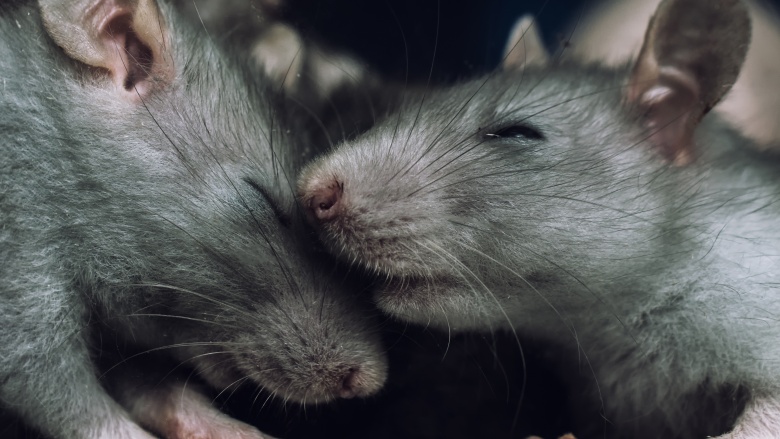Animals Whose Healing Powers Might Surprise You
While humans have gone to extraordinary lengths to remedy their various ailments with pharmaceutical concoctions, some animals won the evolutionary lottery by being able to produce their own natural healing powers. Research has uncovered a bounty of potential for curative cooperation within the animal kingdom lately, and recent discoveries about certain animals' DNA gifts might hold the key to improving our own health, too.
Dog drool rules ... for them
Some pet owners just love to get some sloppy kisses from their four-legged fur babies at the end of a long, hard day of work, but for others, dog drool is just plain gross. Like it or not, though, there's a reason our canine pals are so quick to use their tongues. Licking wounds is actually an instinctual response in dogs and other animals alike (yes, even us humans), because their saliva has tissue factors which promote blood clotting, which in turn is responsible for the scabs that stop a cut from bleeding freely. They can also ward off serious pathogens that might infect their puppies, which is why it's common to see a nursing dog giving her newborn regular tongue baths.
But experts caution against humans turning to their pooches for some salivary support in times of need, because while doggy dribble is great for healing their own open wounds, they also contain a bevy of bacteria that could be harmful for us two-legged types. Dogs' mouths commonly contain bacteria called pasteurella and bartonella, which can cause infection to humans whose gashes are exposed to some of those delicious doggy kisses. They can also harbor parasites that can have serious consequences when spread to people. In other words, while dogs might be able to speed up their own wound recovery process with a little lip service, owners should stick to stocking the medicine cabinet for their own boo-boo treatments.
Rats can sniff out deadly diseases
Unfortunately, rats have long been subjected to medical research — a point of major controversy regarding the humane treatment of animals. However, there's a reason why this particular species has been considered so valuable to so many of these projects across the board: they've got some serious gifts, and are highly trainable.
In 2014, for example, one giant rat in Mozambique was successfully trained to sniff out tuberculosis in Africa, and since it's an airborne disease, his ability to detect the disease with humans at a safe distance is considered invaluable to saving lives. The rat in question, named Charles, had a 70 percent success rate in sniffing out cases of TB in its test cases, which scientists believe is an excellent start to their new detection endeavor.
Rats are also being trained to put those olfactory glands to good use in smelling for landmines in areas thought to have a risk of explosive underground plants in the same region of Tanzania. These guys are basically our saviors, so maybe it's high time we stop blaming them for that whole Plague thing.
Snake venom can help stroke victims
Snakes are some of the most universally feared animals on the planet because, even though the vast majority aren't venomous, one bite from a poisonous snake can be deadly. However, researchers also have reason to believe that even the scariest of these slithery beings could be helpful to humanity as well. According to the New York Times, neurologists have linked the venom from the Malayan pit viper — an animal known to cause fatalities with its gashing bite — to dissolving blood clots.
The properties of the venom, experts say, can decrease the thickness of blood, preventing the kind of clots that cause many human strokes to become severely disabling, or even a death sentence. By purifying the substance, and giving it to stroke victims within a limited window of time, these experts believe they can reverse the potential for the clot to be life-threatening or cause irreparable brain damage, saving lives and increasing quality of life for stroke survivors as well.
Cats purrs are good for the bones
It might seem like our feline friends are simply soothing themselves or expressing contentment when they emit those vibrating purr noises, but being in close contact with a cat while it's audibly enjoying a scratch can be mutually beneficial to the pet's owner in some surprising ways. According to Scientific American, cats emit their purrs at a frequency between 25 and 150 hertz, a range that has been proven to improve bone density and healing in human beings. The noise and sensation has also been linked to stress and blood pressure reduction, and improving joint mobility for those with disabling conditions. That's enough for us to forgive kitty for shattering ten coffee mugs a week.
Pets can help autistic children socialize better
According to researchers from the University of Missouri, children within the spectrum of autism can benefit greatly from having a pet in the home. Among the patients studied for the team's project, kids who had pets of any kind were much more apt to socialize with others, compared to those who didn't.
Gretchen Carlisle, one of the study's conductors, told The Daily Mail, "These kinds of social skills typically are difficult for kids with autism, but this study showed children's assertiveness was greater if they lived with a pet." She added that even when the child wasn't quick to interact with others, the presence of a pet served as a conversational ice breaker of sorts. "Kids with autism don't always readily engage with others, but if there's a pet in the home that the child is bonded with and a visitor starts asking about the pet, the child may be more likely to respond," she explained.
They can also be therapeutic to adults
There's a reason animal-assisted therapy is becoming such a well-respected practice in the world of medicine. Studies have shown that patients who are ill or psychologically distressed greatly benefit from the presence of animals, because they provide creature comfort and companionship to those in need of relaxation, along with a healing environment for chronic condition sufferers. Those with pets experienced more happiness, improved communication and, generally, psychological well-being.
Psychiatric service dogs are now regularly assigned to patients with mental unwellness, like post-traumatic stress disorder, schizophrenia, grief, depression, anxiety, and even bipolar disorder, because they can be individually trained to respond to their caretakers' individual needs. Pet therapy can increase a human's level of oxytocin release, which in turn has healing properties and long-term health.
Dolphins could hold the key to quick healing
With humans, one traumatic wound can lead to severe bleed-out or infection and can be fatal, but dolphins can patch themselves up from the nastiest of gashes with amazing speed and continue on with their daily lives, relatively uninhibited by pain. Dr. Michael Zasloff from Georgetown University told NPR in 2011 that he believes properties that make the underwater mammals so resilient could be beneficial to us landlubbers as well. "Dolphin blubber makes compounds like organohalogens that act as natural antibiotics and keep the tissue from getting infected," he explained. "When the animal restores its wound, it regenerates the complex structure of blubber. It doesn't create a scar; it produces a sort of patch that ultimately is woven back into the surrounding tissue."
The potential for that healing property to translate to humans, he explained, is in the involvement of stem cells, which may contain proteins that could help heal our own wounds ... while limiting the pain process as well. By investigating the tissues that makes up dolphins' blubber, researchers hope to isolate the microbial agents that destroy the dangerous bacteria that would make such wounds fatal in people and find the "long-sought natural morphine that we've been looking for."
Shark tissues can kill viruses
Dolphins aren't the only sea creature housing the potential key to long human lives. Zasloff also discovered in 1993 that the compound in dogfish sharks' tissue, called squalamine, can fight deadly viruses, like dengue fever and hepatitis, which are very hard to treat with ordinary medicines. He also suggested that squalamine might potentially stop cancer cells from multiplying at a molecular level, and it is now used to treat macular degeneration as well. However, more studies are currently underway, to determine its effectiveness against the spread of cancer.
Hibernating bears could help Alzheimer's and dementia patients
In 2015, researchers in the United Kingdom discovered a potential chemical link between hibernating bears and humans who suffer neurodegenerative disorders, like Alzheimer's Disease and dementia. As detailed by BBC, scientists studied the sleeping bears and discovered that, while they slumber through the winter, 20 to 30 percent of their cranial synapses shut down. This part of the bears' brains were successfully reawakened when their bodies returned to the outside in spring.
They discovered that the chemical which allows for this phenomenon is RBM3, which experts believe could be introduced to patients suffering from neurodegeneration, to prevent brain cells from dying off as they normally would during the onset of those diseases. The hope is that memory loss and diminishment of functionality could be prevented by application of an artificial version of that agent.
Mole rats are immune to cancer
Humans are desperate to discover a cure to cancer, as it's one of the top killers across the globe, but there's one type of animal who's simply immune to the disease: the naked mole rat. Researchers at the University of Rochester discovered in 2013 that the naked mole rat can never catch cancer, due to a substance called HMW-HA which makes them resistant to tumors.Experts have since discovered the gene responsible for creating the chemical compound. They hope that, by testing the substance on other animals, it may help prevent tumors and cancers in human beings as well.
There's indirect evidence that HMW-HA would work in people, as it's used in anti-wrinkle injections and to relieve pain from arthritis in knee joints, without any adverse effects. "Our hope is that it can also induce an anticancer response," explained Andrei Seluvanov, co-conductor of the study. If he's right, the cure to cancer might have been right under our noses — er, feet — all this time. That'll make you think twice before smoking out that yard mole next time.










